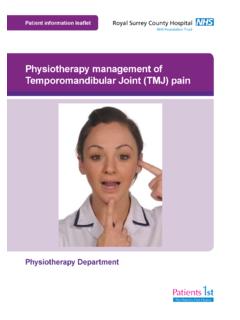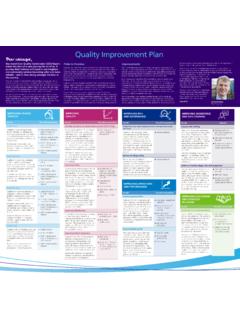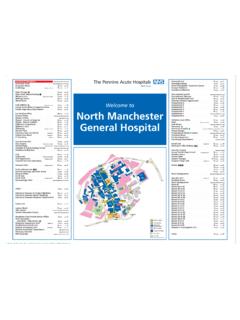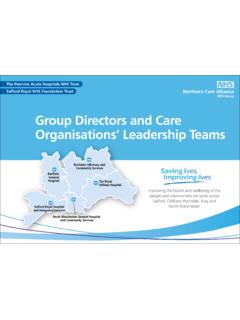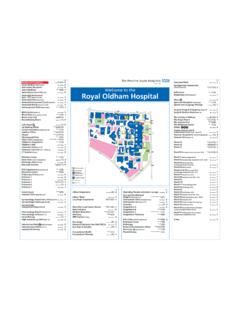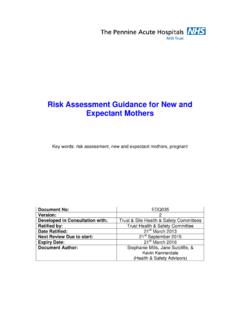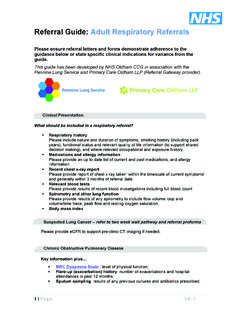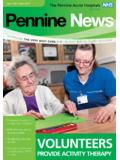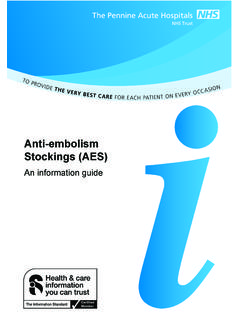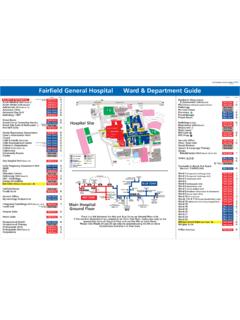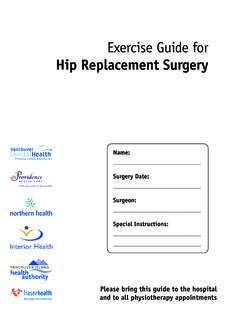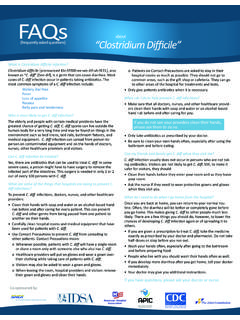Transcription of lower limb Bypass surgery in the
1 TO PROVIDE THE VERY BEST CARE FOR EACH PATIENT ON EVERY OCCASIONIf English is not your frst language and you need help, please contact the Ethnic Health Team on 0161 627 8770 For general enquiries please contact the Patient Advice and Liaison Service (PALS) on 0161 604 5897 For enquiries regarding clinic appointments, clinical care and treatment please contact 0161 624 0420 and the Switchboard Operator will put you through to the correct department / pulp sourced from sustainable forestsJe eli angielski nie jest twoim pierwszym j zykiem i potrzebujesz pomocy prosz skontaktowa si z za og Ethnic Health pod numerem telefonu 0161 627 8770 Bypass surgery in thelower limbAn information guide2 Bypass surgery in the lower limbIntroductionThis leaflet tells you about a variety of operations used to treatblocked arteries in the lower leg.
2 It explains what is involved andwhat the possible risks are. It is not a substitute for the advice whichthe doctor or specialist may give you, but can act as a starting pointfor discussion. Prior to any procedure, you should have a fullexplanation of the procedure and the risks and benefits involvedbefore signing the consent to store your personal informationVascular surgeons record information about surgical interventions,including lower limb Bypass surgery , on the National VascularDatabase (NVD). This is a secure database that is used to helpmonitor and improve vascular services throughout the , you (or your nearest relative) may be asked to givepermission for your personal information to be stored on the the database is a national system, strict data governancemeans personal details on the NVD can only be accessed by staffdirectly involved in an individual's treatment.
3 Patient informationis confidential and is not passed on to third parties other thanhealthcare professionals directly involved in an individual's need to confirm with your vascular surgeon whether you arehappy for them to store your personal information on the is a surgical Bypass ?Surgical Bypass treats your narrowed arteries by creating a newpathway for the blood flow using a graft. Grafts can either be asynthetic piece of material, or one of your veins (if suitable), thatyour surgeon connects above and below the blockage in order toallow the blood flow to pass specific operation will depend on your symptoms, yourgeneral health and how much plaque has built up in your 114/09/2015 15:274 What are the benefits of this operation?
4 When there is a blockage in this artery, the circulation of blood toyour legs is reduced which may cause you to have pain in your calfwhen you walk; this is known as intermittent claudication. Theoperation can improve your quality of life by improving your painand allowing you to walk further. It can also prevent limb loss inthose patients with severe ischaemia ( ulcerations, gangrene) orsevere claudication or pain at may prefer not to have this operation, in which case yourdoctor may then treat you with best medical management . Thismight include taking Aspirin or equivalent daily, good control ofyour blood pressure/cholesterol/diabetes, stop smoking andwalking or exercising regularly (1/2 hour 3-5 times per week) eitherby yourself or part of a structured exercise programme.
5 Howeveryou must be aware that your symptoms may get worse in there anything I can do while waiting for the operation?There are things that you can do to make yourself fitter for thisoperation, and also reduce the risk of developing further diseasecaused by atherosclerosis (hardening of the arteries). if you smoke - give it up! We can refer you to the stop smokingteam for support to quit if you have high blood pressure it is important that it is wellcontrolled before the operation if you are diabetic keep your blood sugars well controlled have your cholesterol (fat in your blood) measured.
6 You may needto take a tablet to lower it5 try to eat a healthy, low fat, low salt diet. Aim for 5 portions offruit and vegetables a day, and fish twice a week (make one an oilyfish such as salmon, mackerel, sardines or tuna).Possible risks/complicationsAs with any surgery there are some risks associated with complications: As with any major operation there is a smallrisk of you having a medical complication such as a heart attack,stroke, kidney failure, chest problems, loss of circulation in the legsor bowel, or infection in the artificial artery. Each of these is rare,but overall it does mean that some patients may have a fatalcomplication from their operation.
7 For most patients this risk isabout 5% in other words 95 in every 100 patients will make a fullrecovery from the operation. Wound infection: Wounds sometimes become infected and thismay need treatment with antibiotics and dressings. Severeinfections are rare. Occasionally, the wound may need to becleaned out under infection: Very rarely (about 1 in 500), the artificial graft maybecome infected. This is a serious complication, and usuallytreatment involves removal of the leak from wound: Occasionally the wound may leak fluid. This may be clear but is usually blood stained.
8 It normally settles intime, and does not usually indicate a problem with the Bypass blockage: The main specific complication of this operationis blood clotting within the Bypass causing it to block. If this occursit will usually be necessary to perform another operation to clearthe Bypass . Very occasionally when the Bypass blocks and the6circulation cannot be restored, the circulation of the foot is so badlyaffected that amputation is swelling: It is normal for the leg to swell after this operationand therefore it is important to rest with your leg up on a stoolwhen sitting. The swelling usually lasts for about 2-3 months.
9 Itnormally goes virtually completely, but may occasionally sensation: You may have patches of numbness around thewound or lower down the leg which is due to the inevitable cuttingof small nerves to the skin. This can be permanent but usually getsbetter within a few : The incision (cut) on your leg is likely to be uncomfortable atfirst. The nurses will monitor your level of pain and pain killers willbe given as prescribed. The pain will slowly improve, but you mayget twinges and aches for between 3-4 weeks. It is important thatyour pain is controlled so that you can move infection: These can occur following this type of surgery ,particularly in smokers, and may require treatment with antibioticsand sores: (bed sores) can occur in 4% to 10% of patientsadmitted to hospital.
10 Certain parts of the body which are at higherrisk of damage include heels, buttocks and sacrum. Preventativemeasures will be discussed with vein thrombosis: (blood clot in the legs) can occur followingsurgery. Preventative measures such as daily injections of a bloodthinning medicine can help reduce the risk of clots embolism: (blood clot in the lungs) can occur followingsurgery. Preventative measures such as daily injections of a bloodthinning medicine can help reduce the risk of clots you are worried about any of the aspects of surgery please askone of the medical or nursing staff. You will be helped to make thedecision about whether to have surgery , but the final decision willbe your operationBefore you come into hospital, you will be asked to attend thepreoperative assessment clinic.
